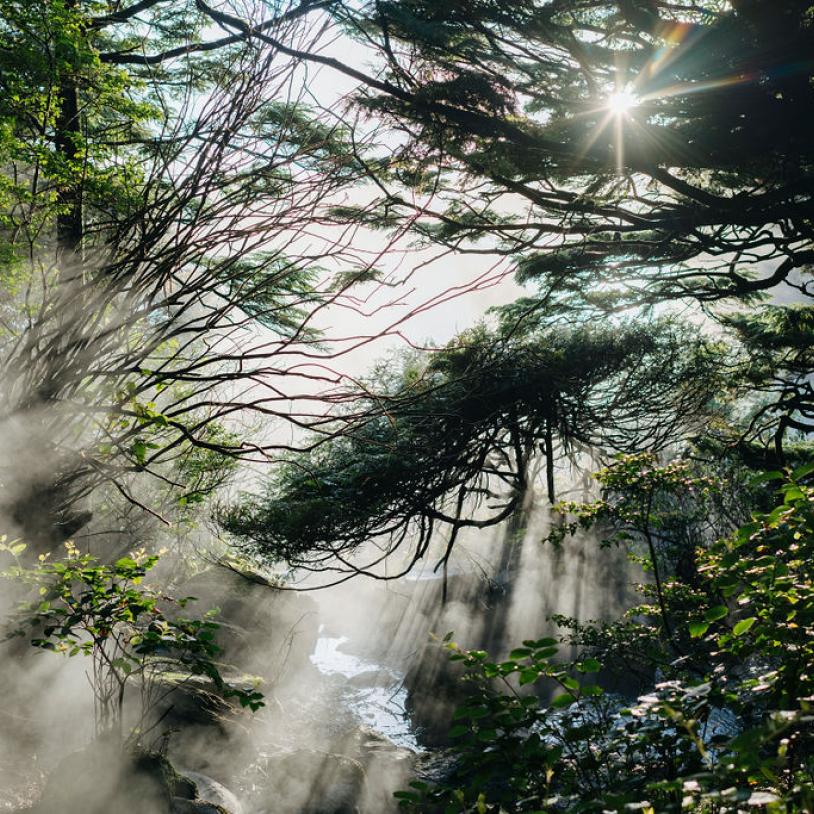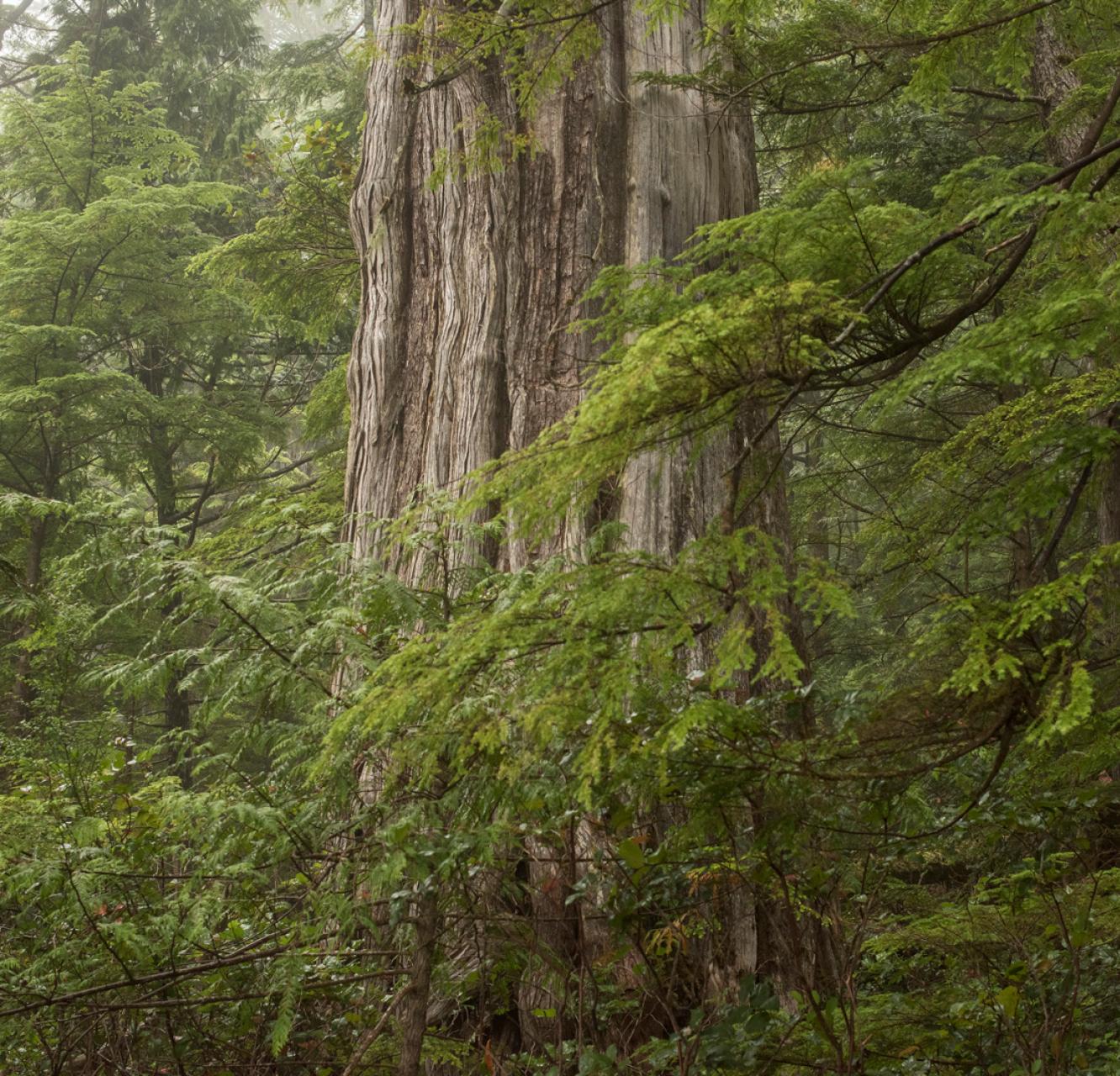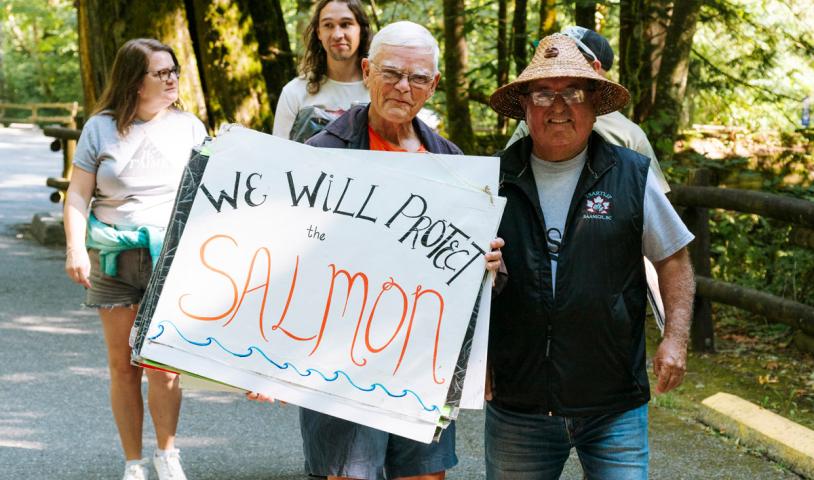Lyell Island: 25 years later
Saturday, November 20, 2010
Conflict over sustainable resource use, old-growth forest depletion and aboriginal land rights converged on one remote logging road off the B.C. coast in 1985. It marked the end of an epoch
The world watched as proud and defiant Haida -- some elders in ceremonial button blankets -- were arrested one after another for blocking a logging road somewhere out on the edge of nowhere.
White justice and values squared off against aboriginal rights.
So did old-growth logging versus environmental sustainability.
It wasn't that black and white, but that's how it came across. And no one knew how it would all end, the potential for violence between the two factions a real possibility.
"We thought it would get physical with the loggers," reflected Guujaaw, now president of the Council of the Haida Nation. "We were fully prepared. But it never came to that."
The period was November 1985, the location Lyell Island on south Moresby Island.
Western Forest Products had the cutting rights to Lyell Island, and Frank Beban Logging Ltd. was the contractor. The approval of new cutting permits touched off the Haida blockade.
No matter where you stood on the issue at the time, it is generally agreed a quarter century later that the political and geographic map changed in large part due to Lyell Island.
Not just on the Queen Charlotte Islands -- now officially known as Haida Gwaii -- but throughout the B.C. coast in terms of the move toward more sustainable logging practices and assertion of aboriginal rights.
"At the time, our people had very little influence over anything," Guujaaw continued. "That's what it took to shake it up and change things. It was our fight.
"It was pretty much unknown ground at that time. It wasn't known what the response of the loggers would be or what the response of the courts would be. There were about 25 police on Lyell Island at the beginning."
A total of 72 people were arrested over a two-week period, beginning with elders Ethel Jones, Ada Yovanovich and Watson Pryce on Nov. 16. The late iconic Haida artist Bill Reid attended the blockade but was not arrested.
"The elders themselves decided that," Guujaaw said. "In fact, they were asked not to [protest]. They insisted, they wanted to be the first ones to make their point. And they were quite willing to take the consequence, no matter what that was."
Of the 72, a dozen were charged and convicted of contempt and given probationary sentences, including Guujaaw, who held no political office at the time.
"We didn't use lawyers. We represented ourselves. We certainly weren't trying to beat it on technicalities or deny that we did it. We went into court to explain why we felt we had to do it."
Guujaaw recalled that the late TV broadcaster Jack Webster was "dead set against us" but through regular coverage of the blockage "at 9 a.m. precisely" helped to raise awareness. It also didn't help that much of the B.C. cabinet at the time held shares in Western Forest Products.
"It put it to the top. It became a national issue," said Guujaaw, noting the news coverage extended overseas.
THE AFTERMATH
On July 11, 1987, the Canadian and B.C. governments signed a memorandum of agreement creating what is today the 1,495-squarekilometre Gwaii Haanas National Park Reserve and Haida Heritage Site.
Two weeks later, Frank Beban died of a heart attack at age 47 while supervising the removal of equipment from his Lyell Island camp.
"He'd had some heart problems," explained Pat Armstrong, who was living in Sandspit and working as a heavy-duty mechanic and welder for Crown Zellerbach at the time.
"He'd quit drinking. He'd cleaned up his act. But when this whole thing came unglued he started drinking again. He was well known for being very dedicated to his employees.
"It was a heartbreaker for him. I don't think there's any doubt about that."
Armstrong had been a chief spokesman for Moresby Island Concerned Citizens, which supported 60 per cent of south Moresby becoming a provincial park, excluding Lyell Island.
"We felt the federal government was arrogant and didn't care about the interests of the local community," he said.
Armstrong joined the Social Credit Party and supported Bill Vander Zalm's successful bid for the leadership in 1986, none of which could stop the momentum for a national park that would cover all south Moresby.
Ottawa and the Haida later agreed to co-manage the national park reserve, a model that even today attracts aboriginals from throughout Canada, as well as New Zealand and Australia. "We told [Ottawa] that if they don't have an acceptable agreement with us, they won't put up one outhouse in there," Guujaaw said.
Another legacy of Lyell Island and the national park reserve is Gwaii Trust, which now totals close to $100 million, to further "economic diversification and sustainable development," which, for the record, does not preclude logging.
"We're logging, but it's under a more responsible management regime," Guujaaw confirmed. "We've knocked it down to about a third of what it was in those days. It's become more a sustainable and ecosystem-based management, more respect for culture and wildlife."
While the national park benefited some, it didn't help Sandspit, Armstrong said. "It clearly has not gained a heck of a lot. It's not a ghost town, but it's not at all a vibrant community."
Today, Armstrong runs Moresby Consulting in Nanaimo, specializing in conflict resolution over issues of natural resources and sustain-ability. He was closely involved with forest companies and conservation groups seeking resolution over logging issues in the Great Bear Rainforest, on the central and north coast.
"South Moresby set me on that direction," he confirmed. "It moved me from being a protagonist to an advocate for finding solutions."
Although environmentalists had a major impact in raising awareness for south Moresby in the 1980s, the Haida made it clear that Lyell Island was their show, even though Burnaby NDP MP Svend Robinson did show up to support them.
'SETTING THE MOULD'
Vicky Husband has served more than 30 years in the conservation movement, including with B.C.'s Sierra Club, and holds the Order of B.C. and Order of Canada for her conservation efforts.
Husband recalled holding protests outside the legislature in Victoria in 1985 to support the Lyell blockade, and how natives had flexed their muscles one year earlier at Meares Island on Vancouver Island.
Tla-o-qui-aht native chief Moses Martin in 1984 declared Meares Island a tribal park, and, in solidarity with nonnative protesters, blocked loggers from arriving by boat. The natives later obtained an injunction against logging by MacMillan Bloedel Ltd.
"There were signs as you came into Tofino: Save Meares Island, Keep Meares Island Green."
Husband reflected that protests such as Lyell Island, Meares Island and, later, Clayoquot Sound were "major stepping stones" towards a comprehensive, multi-stakeholder land-use agreement now in place for the Great Bear Rainforest on the coast.
One exception, she argued, is Vancouver Island, where oldgrowth logging continues of ancient trees with little government oversight. "It still goes on. There is no control."
Joe Foy of the Western Canada Wilderness Committee and a leading advocate for ending old-growth logging in the province, credits the Lyell Island blockade with helping to "set the mould for the unique way forest protection played out in B.C. over the following decades."
He cited alliances between environmental groups and first nations, logging road protests, and strong images of nature and first nations traditional governments. Protests such as the Stein Valley and Elaho Valley reflected the "B. C. way of protecting wild nature," he said, adding the level of park protection has more than doubled "to over 14 cent."
"When people now see old growth, they think, that should be in a park," he said. "Lyell started that."
LEGACY LIVES ON
Jeff King bought the community newspaper the Observer, just as the logging protests began on Lyell Island.
"It was more story than I wanted on my front yard for my first week," he said from Queen Charlotte City.
King recalled how the protest pitted different factions against each other on the islands, even within the Haida community.
"Many of the people who made their living as loggers on these islands then were Haida," he said. "I'm sure it divided Haida families. It certainly divided the communities along [the lines of] those who supported and did not support the protests."
It took some time for the bitterness to subside, he said, and the social makeup of Haida Gwaii to change.
No longer a stronghold of loggers and fishermen, the community has become more cosmopolitan and accepting of the strong aboriginal voice in management of the islands, he said. "There are still logger red-necks out there, but they're all 75 years old and there's few of them left. Aboriginal rights are here to stay."
In a recent editorial for the Observer, King wrote: "The 1985 protests were a marker. They marked the end of one epoch and the beginning of another, as did other protests like Meares [Island] and the Stein Valley, an end of the time when governments could ignore first nations. . . ."
Award-winning Victoria journalist and author Terry Glavin covered Lyell Island for The Vancouver Sun and described the blockade as a "seminal event" in terms of aboriginal people asserting their rights.
"It was heavily charged with import," he said. "You had the great iconic images of little women in button blankets and grey hair against the forces of the forest industry and the police.
"It seemed to gather together in one remote logging road confrontation all these epochal, global conflicts over sustainable resource use, old-growth forest depletion, conflicts between the assertion of aboriginal rights and title against Crown sovereignty and the industrial development of Canada."
But he said many of the nuances of the moment were lost, arguing it wasn't a simple matter of whites versus natives or logging versus parks. At the time, there was substantial support within the forest industry for more sustainable cutting practices, he said, adding there was also support Canada-wide for the native cause.
He recalled how an RCMP special constable confided in him at the time about the difficulty of arresting his own people. By the time his copy made it into the paper, it appeared that the constable's first allegiance would be to the Haida, not the law. Glavin said he was furious, and let his editors know it.
Shortly before he returned to the office at Granville Street and Sixth Avenue, "somebody had side-swiped a bunch of cars on Sixth Avenue, including a couple of editors', and I was told later that there was an assumption [I'd done it]," he laughed over the phone.
Guujaaw confirmed there were gentler, even humorous, moments despite the tense start to the Lyell blockage.
Natives had a feast for the loggers to show the blockade was not directed at them personally.
"Police were spending a lot of time at our camp because I think we had the better grub," he added. "They were doing their part, chopping wood and getting along with everyone.
"Fact is, we were up too late one night and they were the ones down there waking us up."
Gerry Kahrmann, now a photographer for The Sun, recalls the Haida leaving the island to attend a funeral and the loggers agreeing not to proceed with logging during their absence -- just as German and British troops declared a Christmas truce in 1914 during the First World War.
"It was also Grey Cup weekend," Kahrmann said. "The RCMP had brought communications guys in. They realigned the [logging camp] satellite dish so we could get CBC. And the cook flagged down a prawn boat that morning. When the Grey Cup started, she brought in a galvanized tub filled with fresh spotted prawns. It was like the best Grey Cup ever."
(For the record, the B.C. Lions defeated the Hamilton Tiger-Cats in the Canadian Football League final, 37-24.)
Old growth in B.C.
Current old-growth statistics provided by B.C.'s Ministry of Forests, Mines, and Lands:
- The Coast Forest Region covers 15.8 million hectares, with 3.14 million hectares in parks and protected areas. Of the 7.6 million hectares of Crown productive forests, four million hectares are considered oldgrowth; 769,000 hectares of Crown old-growth are available for harvesting.
- The protected areas, as well as areas available for harvesting, are the result of land-use planning processes -- with one of the most significant being the February 2006 Coastal Land Use Decision -- that protect 1.8-million hectares from resource activity.
- Since 1995, the amount of second-growth harvested has increased to 29 per cent from five per cent. It has the potential to increase to 44 per cent over the next decade.





